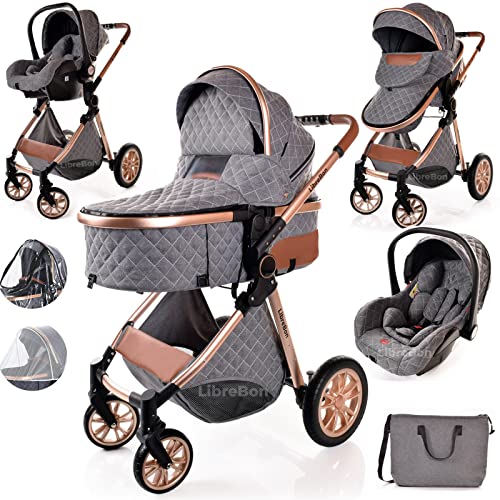Pram or Pushchair: A Comprehensive Guide for New Parents
Picking the ideal mode of transport for young kids is one of the first substantial choices brand-new parents deal with. With numerous alternatives on the market, the argument between prams and pushchairs can be overwelming. visit the following internet page will provide comprehensive insights into the differences in between prams and pushchairs, their specs, benefits and disadvantages, and what to consider before making a purchase.
Comprehending Prams and Pushchairs
At its core, the choice between a pram and a pushchair lies in their design and intended usage.
Definitions:
- Pram: A pram, brief for "perambulator," is designed mainly for newborns. It features a flat, carrycot-style seat that enables the baby to rest entirely flat. Prams are typically more glamorous and are intended for transferring infants who are not yet staying up individually.
- Pushchair: A pushchair, likewise referred to as a stroller, is created for older infants and young children who can stay up. Pushchairs normally have an upright seat and may not recline totally flat, although lots of models now provide adjustable reclining alternatives for comfort.
Secret Differences:
| Feature | Pram | Pushchair |
|---|---|---|
| Age of Use | Newborn to about 6 months | 6 months to 4 years or more |
| Seating Position | Flat, resting | Upright or slightly reclined |
| Weight | Typically heavier | Usually lighter |
| Mobility | Less portable due to weight | More portable and simpler to fold |
| Usage Case | Short strolls, leisurely walks | Daily usage, errands, longer getaways |
Benefits and Disadvantages
Pram
Benefits:
- Comfort for Newborns: Provides a flat surface conducive to a newborn's developmental requirements.
- Stylish Designs: Many prams come with elegant styles, providing a touch of luxury.
- Storage Space: Sometimes consist of bigger storage alternatives below.
Disadvantages:
- Weight: Generally much heavier and bulkier than pushchairs.
- Minimal Usage: Suitable just for newborns and babies who can not sit up.
Pushchair
Advantages:
- Versatility: Suitable for older babies and toddlers, often accommodating them for several years.
- Light-weight and Portable: Easier to fold and transport, making them perfect for hectic parents.
- Configurable Options: Many pushchairs have adjustable seats and attachments for safety seat and carrycots.
Downsides:
- Comfort for Newborns: Not always suitable for infants in the early months without an appropriate insert.
- Less Luxurious: Often viewed as less elegant compared to prams.
Making the Right Choice
When it pertains to choosing in between a pram and pushchair, numerous factors need to be considered:
1. Lifestyle:
- If moms and dads frequently make long trips or choose strolls, a pram may be preferential.
- If they need to navigate through city streets or take public transportation, a light-weight pushchair might be preferable.
2. Budget plan:
Pricing can vary widely. Understanding your monetary limits will assist concentrate on alternatives that meet both aesthetic and useful criteria.
3. Versatility:
Some progressive services include travel systems that permit moms and dads to transition from a safety seat to a pushchair with the same base, offering maximum versatility.
4. Storage Space:
A pram may take up more space in an automobile or in your home, while a pushchair's ability to fold down can be a substantial advantage in tighter areas.
Frequently asked questions
Q1: Can I utilize a pushchair for newborns?
A1: Some pushchairs include bassinet attachments or totally reclining seats, making them appropriate for newborns. Nevertheless, it's important to inspect the specs before use.
Q2: How do I pick the right model?
A2: Consider your lifestyle, budget, and the functions you prioritize, such as weight, mobility, and storage options.
Q3: Are prams and pushchairs safe for my baby?
A3: Yes, both prams and pushchairs are created with safety features. Look for models with a 5-point harness, durable brakes, and secure frames.
Q4: How long can I utilize a pram for?
A4: A pram is typically ideal till a baby can stay up unassisted, generally around 6 months.
Q5: What are travel systems?
A5: Travel systems are mixes of a vehicle seat and a pushchair that work in tandem, permitting easy transitions from vehicle to pushchair without needing to get rid of the baby.
Choosing in between a pram and a pushchair ultimately boils down to the needs and way of life choices of each family. Prams use convenience and style for babies, while pushchairs supply versatility and ease for older babies and toddlers. By carefully considering private scenarios and requirements, parents can make an informed option that will ensure safe and pleasurable outings with their little ones.
In the end, whether one select a stylish pram or a useful pushchair, the main goal stays the exact same-- making sure convenience and safety for the child while facilitating convenience for moms and dads.

